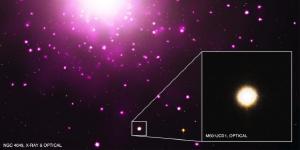Blog
A Million Star Sky
18 September 2014
 NASA
NASAOn a dark night with good viewing conditions, you might be able to see about 4,000 stars with the naked eye. Imagine, then, if you could see a million stars with the naked eye. For such a sky, our galaxy would need to be much more densely packed. While we won’t see such a sky anytime soon, it could exist on a planet in the most densely packed galaxy yet discovered. It is known as M60-UCD1, and it is a rather curious galaxy.
M60-UCD1 is an ultra-compact dwarf galaxy. It only has about 140 million stars, but those stars are contained within a volume about 300 light years wide. As a recent paper in Nature announced, it also has a supermassive black hole in its center.1 The mass of that black hole is about 15% of the total mass of the galaxy, which is an extraordinarily large fraction. By comparison, the black hole in the center of the Milky Way only makes up about 0.01% of our galaxy’s mass.
Just how such a dense galaxy could have formed is a bit of a mystery. The most popular idea is that it was once a large galaxy with billions of stars, but then collided with another galaxy that stripped most of its outer stars, leaving a dense core of stars surrounding a supermassive black hole. The fact that this dwarf galaxy is near a larger galaxy known as M60 gives this idea a bit of credence.
M60-UCD1 is 54 million light years away, so we won’t be able to visit its planets anytime soon, but it would be cool to stand on one of its worlds and look up at a million stars.
Seth, Anil C., et al. “A supermassive black hole in an ultra-compact dwarf galaxy.” Nature 513.7518 (2014): 398-400. ↩︎